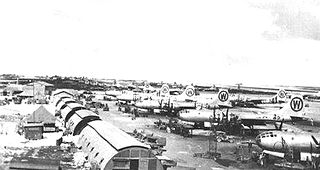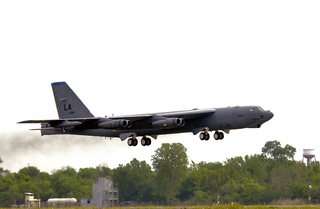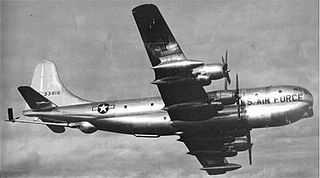
McCook Army Airfield was activated on 1 April 1943. It is located nine miles (14 km) northwest of McCook, a city in Red Willow County, Nebraska, United States and is southwest of North Platte, Nebraska. It was constructed in 1943. The 2,100-acre (8.5 km2) site is bordered on all sides by level farm ground.

Fairmont State Airfield is three miles south of Fairmont, in Fillmore County, Nebraska. The National Plan of Integrated Airport Systems for 2011–2015 categorized it as a general aviation facility. It has no scheduled airline service.

The 49th Air Division is an inactive United States Air Force unit. Its last assignment was with the United States Air Forces in Europe at RAF Sculthorpe, England. It was inactivated on 1 July 1956.

The 484th Air Expeditionary Wing is a provisional United States Air Force unit assigned to Air Combat Command. It may be activated or inactivated at any time. It was activated and attached to United States Air Forces Central for the invasion of Iraq in 2003. It was headquartered at Prince Sultan Air Base, Saudi Arabia.

The 468th Bombardment Group was a World War II United States Army Air Forces combat organization. The unit served primarily in the Pacific Ocean theater and China Burma India Theater of World War II as part of Twentieth Air Force. The 468th Bomb Group's aircraft engaged in very heavy bombardment Boeing B-29 Superfortress operations against Japan. After its reassignment to the Mariana Islands in 1945, its aircraft were identified by a "I" and a triangle painted on the tail. It was inactivated on 31 March 1946.

The 467th Bombardment Group is an inactive United States Army Air Forces unit. Its last assignment was to the Strategic Air Command, being stationed at Clovis Army Airfield, New Mexico. It was inactivated on 4 August 1946.

Dalhart Army Air Base is a former World War II military airfield complex near the city of Dalhart, Texas. It operated three training sites for the United States Army Air Forces from 1943 until 1945.

The 505th Bombardment Group is an inactive United States Air Force unit. Its last assignment was with Thirteenth Air Force, stationed at Clark Field, Philippines. It was inactivated on 30 June 1946.

Grand Island Army Airfield was a United States Army Air Forces airfield which operated from 1942 to 1946. After its closure, the base was reopened as Central Nebraska Regional Airport.

The 497th Bombardment Group was a group of the United States Army Air Forces. The unit was inactivated on 31 March 1946.

The 340th Weapons Squadron is a United States Air Force unit assigned to the USAF Weapons School. It is stationed at Barksdale Air Force Base, Louisiana. The 340th is assigned to the 57th Wing, at Nellis Air Force Base, Nevada. The mission of the squadron is to provide Boeing B-52 Stratofortress instructional flying.

The 829th Bombardment Squadron was a squadron of the United States Army Air Forces. It was active during World War II in the Mediterranean Theater of Operations as a Consolidated B-24 Liberator unit, where it earned a Distinguished Unit Citation. Following V-E Day, the squadron returned to the United States and began training with the Boeing B-29 Superfortress at Smoky Hill Army Air Field, Kansas, before inactivating in August 1946.

The 828th Bombardment Squadron was a squadron of the United States Army Air Forces. It was active during World War II in the Mediterranean Theater of Operations as a Consolidated B-24 Liberator unit, where it earned a Distinguished Unit Citation. Following V-E Day, the squadron returned to the United States and began training with the Boeing B-29 Superfortress at Smoky Hill Army Air Field, Kansas, before inactivating in August 1946 ans transferring its personnel to another unit that was activated in its place.

The 303rd Air Refueling Squadron is an inactive United States Air Force unit. It was last assigned to the 499th Air Refueling Wing at Kindley AFB, Bermuda, where it was inactivated on 15 June 1963.

The 824th Bombardment Squadron is an inactive United States Air Force unit. It was last assigned to the 484th Bombardment Wing at Turner Air Force Base, Georgia, where it was inactivated on 25 March 1967.

The 825th Bombardment Squadron is an inactive United States Air Force unit. It was assigned to the 484th Bombardment Group and was last stationed at Casablanca Airport, French Morocco, where it was inactivated on 25 July 1945. The squadron was activated during World War II as a Consolidated B-24 Liberator unit. It served in combat in the Mediterranean Theater of Operations, earning two Distinguished Unit Citations for operations over Germany and Austria. Following V-E Day it operated with Air Transport Command in returning American troops to the United States until it was inactivated in theater in the summer of 1945.

The 826th Bombardment Squadron is an inactive United States Air Force unit. It was assigned to the 484th Bombardment Group and was last stationed at Casablanca Airport, French Morocco, where it was inactivated on 25 July 1945. The squadron was activated during World War II as a Consolidated B-24 Liberator unit. It served in combat in the Mediterranean Theater of Operations, earning two Distinguished Unit Citations for operations over Germany and Austria, during the strategic bombing campaign against Germany. Following V-E Day it operated with Air Transport Command in returning American troops to the United States.

The 827th Bombardment Squadron is a former United States Army Air Forces unit. It was last assigned to the 484th Bombardment Group at Casablanca Airport, French Morocco, where it was inactivated on 25 July 1945.

The 484th Bombardment Squadron is an inactive United States Air Force unit. It was last assigned to the 505th Bombardment Group at Clark Field, Philippines, where it was inactivated on 10 June 1946.

Sioux City Air National Guard Base is an Iowa Air National Guard base, located at Sioux Gateway Airport It is located 7.2 miles (11.6 km) south-southeast of Sioux City, Iowa. On 25 May 2002, the airport was named "Colonel Bud Day Field" in honor of United States Air Force Colonel George Everette "Bud" Day, a Sioux City, Iowa native and is the only person ever awarded both the Medal of Honor and the Air Force Cross.




















